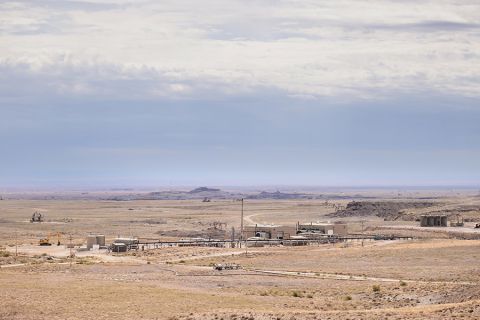
Nothing exemplifies the phrase, “Hope springs eternal,” like the start of a Major League Baseball season. After all, every team is 0-0 with a long 162-game season to play out. While fans of perennial contenders like the San Francisco Giants and New York Yankees typically have more reason for optimism, other fanbases need look no further than the Kansas City Royals as representing the chance for a new beginning. After ending a nine-year losing streak in 2013, the Royals won the American League pennant and took the Giants to seven games before losing in the World Series.
On the flip side there is every chance that a perennial contender can slip the other way and have a losing season.
It is becoming increasingly clear that 2015 will be one of these “lost years” for crude oil, natural gas and NGL prices. The hope here is that it will be a minor blip such as the one that the Boston Red Sox had a few years ago when they suffered a losing season in 2012, but bounced back to win the 2013 World Series.
There is a very strong likelihood that this is the case as long-term forecasts still show growth in demand for each of these products on a global basis despite the short-term struggles.
West Texas Intermediate (WTI) crude oil prices saw slight improvements and natural gas prices were down slightly as the month of March entered its final full week. This resulted in a mixed bag for NGL prices with propane, butane and isobutane down at Conway and Mont Belvieu from the previous week, but ethane and C5+ prices experienced gains at both hubs.
As we have been reporting the last few weeks at Midstream Business, there have been very large storage builds at the Cushing, Okla., hub. However, the capacity expansions that have taken place at the hub in recent years are helping to lessen fears of capacity constraints in the coming months.
In addition, increased refining demand could tighten the WTI market in the coming months, according to Tudor, Pickering, Holt & Co. “Current price differentials for various North American grades suggest a shift in U.S. refiner consumption trends is potentially ahead that could tighten the WTI market and strengthen pricing,” the investment firm said in a March 26 research note. “WTI currently appears as the most attractively priced barrel available to PADD 2 and 3 refiners, thus we see increased near-term demand from rising utilization coming off seasonal spring maintenance and possible incremental displacement of Gulf Coast medium crude imports. This dynamic could tighten Brent/WTI differentials back to transportation economics and represent the first inflection point towards a structural bottoming of the domestic oil market.”
While it is unlikely that WTI prices will begin a rapid recovery in the coming weeks, staying above the current $50 per barrel level would help heavy NGL prices make gains. Butane and isobutane have lost value since the start of 2015, but this is to be expected since refiners are now switching from blending winter-grade gasoline to summer-grade gasoline. The NGL with the closest relationship to crude, C5+, has experienced 10% gains at both hubs as crude prices have slightly improved in the first quarter.
Natural gas prices began to fall due to decreasing heating demand as the spring shoulder season arrives. The Conway price fell less than 1% to $2.49 per million Btu (/MMBtu) and the Mont Belvieu price dropped 2% to $2.60/MMBtu. Until the summer cooling season increases demand from gas-fired power generation, it is unlikely that gas prices will gain much upward momentum, since the storage injection season is now upon us.
“Last week’s reported withdrawal is likely to be the last of the heating season with moderate builds projected for the next two U.S. Energy Information Administration (EIA) reports,” PIRA Energy Group said in its March 25 Weekly Natural Gas, Power and Coal Market Recap.
Indeed, the EIA reported that natural gas storage levels increased by 12 billion cubic feet (Bcf) to 1.479 trillion cubic feet (Tcf) the week of March 20 from 1.467 Tcf the previous week. This was 64% greater than the 904 Bcf reported last year at the same time and 12% lower than the 1.673 Tcf five-year average.
While ethane prices continued to follow natural gas prices, they did manage to make slight gains this week as ethane stocks are decreasing on a month-to-month basis due to the return of cracking capacity. The biggest headwind still facing the industry is the series of unplanned cracker outages and turnarounds. However, the majority of these plants are expected to be back online by the first week of April, which should help to continue to work off the ethane storage overhang throughout the rest of the year.
Contact the author, Frank Nieto, at fnieto@hartenergy.com.



Recommended Reading
Matador’s U-lateral Delaware Tests Outproduce 2-mile Straight Holes
2024-10-30 - Matador Resources' results from eight Loving County, Texas, tests include two 2-mile U-turn laterals, five 2-mile straight laterals and one 1-mile straight lateral, according to state data.
Hot Permian Pie: Birch’s Scorching New Dean Wells in Dawson County
2024-10-15 - Birch Resources is continuing its big-oil-well streak in the Dean formation in southern Dawson County with two new wells IP’ing up to 2,768 bbl/d.
VTX Energy Quickly Ramps to 42,000 bbl/d in Southern Delaware Basin
2024-09-24 - VTX Energy’s founder was previously among the leadership that built and sold an adjacent southern Delaware operator, Brigham Resources, for $2.6 billion.
Now, the Uinta: Drillers are Taking Utah’s Oily Stacked Pay Horizontal, at Last
2024-10-04 - Recently unconstrained by new rail capacity, operators are now putting laterals into the oily, western side of this long-producing basin that comes with little associated gas and little water, making it compete with the Permian Basin.
Comstock: Monster Western Haynesville Wildcats Cost $30MM-plus
2024-10-31 - Comstock Resources is flowing back a 13th well currently in the play where the oldest has made 2.2 Bcf per 1,000 lateral feet to date in its first 29 months online.
Comments
Add new comment
This conversation is moderated according to Hart Energy community rules. Please read the rules before joining the discussion. If you’re experiencing any technical problems, please contact our customer care team.





